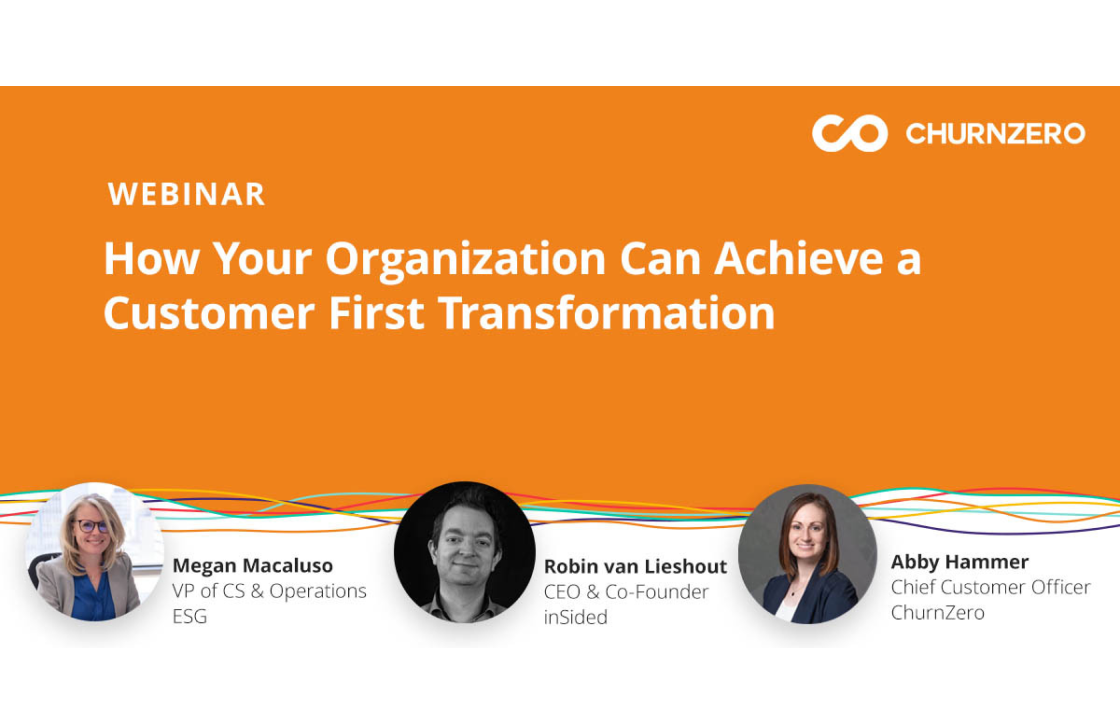Customer centricity: Something many organizations strive towards, but truly getting there can be a challenge. In a recent webinar with ChurnZero CCO and Head of Product, Abby Hammer and inSided CEO and Co-Founder, Robin van Lieshout, we discussed what being a customer centric organization really entails and how more of us can achieve the transformation.
Want to see the webinar in full? Click here to watch it on-demand.
Thanks to Megan Macaluso from ESG for facilitating.
We kicked off by polling the audience (approximately 400 Customer Success practitioners) on how customer centric they feel their organizations are currently. An encouraging 31% of audience members felt that their organization was indeed customer centric ‘to a great extent’, and a further 54% felt their organization was ‘somewhat’ customer centric. Only 15% of participants believed their companies showed very little customer centricity.

But what does it really mean to be customer centric?
For Abby, being customer centric comes down to putting the customer at the forefront of every decision you make—really trying to think like the customer. Often we talk about how a decision might impact a customer, but was the customer at the forefront of the thinking before the decision was made? Are we being proactive, or are we being reactive in terms of support? Are customer centric metrics in the mix of our overall reporting?
In Robin’s opinion, the customer experience is key. Maybe customer centricity even requires organizations to define value as customer-first, not product-first. Ultimately, understand that the customer really is at the center of everything you do—there is no one single metric for ‘measuring’ customer centricity.
Ultimately, Abby, Robin and Megan agree that customer centricity is really an organizational mindset, and the Customer Success department needs to help embed this mindset across and into the rest of the organization.
How to structure your teams to better serve the customer
Next, we discussed how teams can be structured optimally to not only better serve the customer but facilitate customer centricity across the board.
Some tips from Abby:
- Ask yourself: What type of meetings do we have?
- Which metrics do we measure?
- How do we need to be compensating and incentivizing teams to behave in the way we want?
The exact actions you take are going to vary, but be specific about how you act. Structure your Customer Success programs in a way that matches customer expectations, and always communicate!
Robin adds: A strong CS leader is vital, and signals to the organization the value that is being placed on customer centricity. Put self-service first—we all see the preference for self-service has overtaken, and then have an engagement manager as part of your one-to-many strategy.
The future is also in a deeper relationship between Customer Success and the product arm of the organization. The way ChurnZero has approached this is a real boost: is set up is a real boost: Abby’s not only the CCO, but she’s also the Head of Product, which may seem unusual, but works for ChurnZero as a Customer Success software vendor, ensuring that the CS team is tightly aligned with the product.
Does your organisation already have an online customer community?
Our second poll to the audience asked: Does your organization already have an online customer community?

79% of the CS practitioners we polled either already have an online community place or are considering implementing one—which makes sense when it comes to scaling self-service and servicing low-touch or tech-touch segments of the customer base.
⚙️ What processes should be put in place to drive customer engagement and adoption?
Abby’s suggestions:
- Get the voice of the customer into your CS programs
- Move them along the value points, while also enriching their experience of working with your organization—outside of simply being ‘just a vendor’.
- Consider how you can introduce them to and connect them with their peers—especially at C-level
- Don’t focus so much on the high-touch meetings: Lean on and optimize your self-service offering. Note, that doesn’t mean the process shouldn’t be well thought-out!
Robin shared some experience and processes we use at inSided:
- We immediately introduce new customers to our community, even before onboarding—much of our best practice and onboarding information is hosted there.
- We actually see that many of our prospects browse our community, see how we manage the community, see our thought leadership, and how we react to and interact with product feedback, before or in the early stages of talking to sales. So their relationships with our community actually often begin before they become a customer.
- As you scale, tools like ChurnZero for customer journey mapping and a 360 view of the customer, and inSided from a customer success community perspective, really form part of that integral tech stack.
During the webinar, Abby, Robin and Megan also talked in detail about using community for product feedback, ideation and closing the feedback loop. You can find more resources on that here.
How do you ultimately know if you’re successfully customer centric?
Abby:
- There should be an overall feeling and demonstration of organizational accountability
- Do you have a real sense of community amongst your customers?
- Is your customer experience consistent?
- Are you constantly evolving your customer experience programs and offerings? Because customer centricity is a topic that never ‘dies out’.
Robin:
- I don’t think there is one single metric; it goes back to mindset
- As a CEO, be honest with yourself. You probably have a sense, a gut feel on how you’re doing on this
- Are you creating buzz around your brand, are people talking about you, are you the default choice in your industry, do you have loyalty, do you feel it?
For even more great insights, check out the full Q&A summary over on ChurnZero’s blog! Webinar participants asked questions like:
- How do you tie employee compensation plans to the customer to promote customer-first behaviors or expectations?
- How do you define your customer journey in terms of systems and processes?
- And who should handle renewals at a customer centric organization?
We’d like to give a big thanks to our friends at ChurnZero and ESG for hosting this webinar with us. Sign up for our monthly digest to stay in the loop with new insights on Customer Success and online communities.


